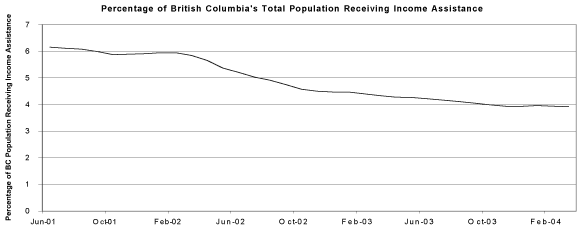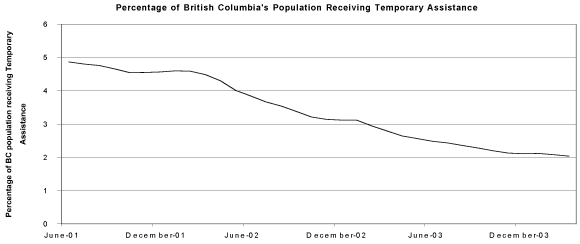Goal 2
BC Employment and Assistance Services Support Self-Reliance.
Core Business Area: Temporary Assistance
Objective 1
Enquirers actively seek work.
Key Strategies
Require enquirers to undertake a three-week self-directed work search.
Performance Measures and Results
Measure 2.1: Percentage of enquirers who contact BC Employment and Assistance Offices and are diverted to employment.
| Performance Measure |
2003/04 Target |
2003/04 Actual |
Target Achieved |
| 2.1 Percentage of enquirers who contact BC Employment and Assistance offices and are diverted to employment |
Establish Baseline |
49% |
Yes |
Conducting a work search was a requirement of individuals who contacted the ministry to request income assistance and must have been completed prior to their application for assistance.
The ministry provided services to assist enquirers to find employment prior to applying for income assistance. Services included web-based orientation sessions, work search guidelines, and an independent work search toolkit. The ministry's emphasis on personal responsibility was demonstrated by the importance placed on assisting clients and enquirers to become self-reliant through employment as quickly as possible.
This benchmark measure reports the percentage of enquirers or applicants for whom assistance was not granted. This may have been because the enquirer did not return to complete an application or that the applicant was not eligible for assistance. Due to difficulties determining why an enquirer did not return to apply for assistance, this measure has been discontinued in the 2004/05 – 2006/07 Service Plan. This performance measure only determined the success of enquirers finding alternatives to income assistance.
Objective 2
Applicants and clients enter into employment plans as a condition of eligibility.
Key Strategies
Establish mandatory obligations to meet employment plan goals for all clients.
Require all existing clients to complete employment plans and review their eligibility.
Performance Measures and Results
Measure 2.2: Percentage of British Columbia's population receiving income assistance.
| Performance Measure |
2001/02 Establish Baseline |
2002/03 Actual |
2003/04 Target |
2003/04 Actual |
2003/04 Variance |
Target Achieved
|
| 2.2 Percentage of British Columbia's population receiving income assistance |
6.0% |
4.5% |
4.8% |
3.9% |
–0.9% |
Yes |
Measure 2.3: Percentage of British Columbia's population receiving temporary assistance.
| Performance Measure |
2001/02 Establish Baseline |
2002/03 Actual |
2003/04 Target |
2003/04 Actual |
2003/04 Variance |
Target
Achieved
|
| 2.3 Percentage of British Columbia's population receiving temporary assistance |
4.5% |
3.5% |
3.0% |
2.0% |
–1.0% |
Yes |
These two performance measures provide an indication of the overall effectiveness of policies and strategies that assisted enquirers' and clients' move toward independence. They were affected by external factors such as the economy, job availability and population growth.
Measure 2.2 indicates that the ministry surpassed its 2003/04 target to reduce the proportion of British Columbians who received income assistance. A growing economy and robust employment growth contributed to this achievement. Internal factors that contributed to this success were the ministry's focus on employment and personal responsibility. Policy enhancements, such as the employment planning process, provided opportunities for greater numbers of ministry clients to achieve independence.
The reduction in the proportion of British Columbians who received temporary assistance, as outlined in Measure 2.3, indicates the greatest reduction in the caseload, relative to the general population, was of clients who were most able to achieve independence through sustained employment.
Historical Context
The percentage of British Columbia's population who required income assistance has been on a steady decline since June 2001. The time series graph below shows that this percentage began the most significant decline in fiscal year 2002/03. The introduction of amendments to the existing legislation in April 2002 marked the beginning of a sharp decline. The introduction of the Employment and Assistance Act and Employment and Assistance for Persons with Disabilities Act in September 2002 continued this trend.

As with the overall reduction in the percentage of British Columbians who required income assistance, the percentage of temporary assistance clients also declined. The time series graph below indicates that more British Columbians found alternatives to income assistance since June 2001. More temporary assistance clients found employment during this same time period.


Measure 2.4: Percentage of total caseload receiving temporary assistance.
| Performance Measure |
2001/02 Establish Baseline |
2002/03 Actual |
2003/04 Target |
2003/04 Actual |
2003/04 Variance |
Target Achieved |
| 2.4 Percentage of total caseload receiving temporary assistance |
76% |
70% |
64% |
48% |
–16% |
Yes |
This performance measure indicates the proportion of the total caseload that was expected to need income assistance for a temporary period of time. Due to the success in moving clients and enquirers into sustained employment it was anticipated the remaining caseload will be increasingly made up of continuous assistance clients.
New Measures (2004/05)
1. Percentage of BC's population aged 19-64 receiving temporary assistance with employment-related obligations.
Clients who leave income assistance for jobs have higher incomes, their children are less likely to receive income assistance as adults, and they attain higher levels of training and education. Children whose parents work are more likely to complete high school and be actively involved in the labour market as adults.
Increasing the number of clients who find employment is a critical aspect of the ministry's mission. As such, the ministry developed this new performance measure to track the ministry's success in this area. All temporary assistance clients have employment-related obligations, except for those who are not required to seek work (e.g., parents of a young child). This new measure provides a more precise accounting of those clients who are expected to achieve independence from income assistance.
| New Performance Measure |
2001/02 Baseline |
2002/03 Actual |
2003/04 Actual |
2004/05 Target |
2005/06 Target |
| Percentage of BC's population aged 19-64 receiving temporary assistance with employment-related obligations (NEW) |
3.4% |
1.7% |
2.2% |
0.9% |
0.87% |
2. Percentage of clients with employment-related obligations who have an active employment plan.
Employment plans are the foundation for planning between ministry staff and clients. These plans establish, for clients who are able to work, clear expectations to achieve independence. This process ensures clients' access to tools and supports required for finding a job and becoming independent of income assistance. Changes were introduced to the development of employment plans in 2003/04.
The new measure reflects the importance of employment plans as a tool to assist clients in moving toward independence. Staff began the process of developing employment plans for clients with employment-related obligations in 2003/04 and will continue to ensure all employment plans are current and active. Higher percentages for this measure indicate success in encouraging self-reliance and in assisting clients achieve independence. In 2003/04 a baseline has been established.
| New Performance Measure |
2003/04 Baseline |
2004/05 Target |
2005/06 Target |
2006/07 Target |
| Percentage of clients with employment-related obligations who have an active employment plan (NEW) |
63.4% |
85% |
95% |
100% |
3. Percentage of persons with persistent multiple barriers who participate in a ministry program.
Some ministry clients face significant barriers to achieving self-reliance through employment such as limited life-skills, minimal employment history, and literacy concerns. The ministry provides clients who face multiple barriers to employment with services aimed at increasing their self-reliance by developing life skills and by providing pre-employment opportunities. Increasing the level of self-reliance of people with multiple barriers to employment contributes to the ministry's ability to achieve its mission.
This new performance measure tracks the percentage of persons with multiple barriers who are served by ministry programs. Involvement in ministry programs is simply a first step. The ministry works to understand the kinds of barriers these clients face so that programs and services can more effectively address their issues. As programs and services for this client group are refined, more precise expected outcomes for clients will be developed.
| New Performance Measure |
2004/05 Baseline |
| Percentage of persons with persistent multiple barriers who participate in a ministry program (NEW) |
Establish Baseline |
|
